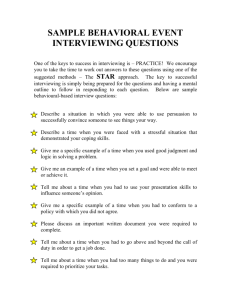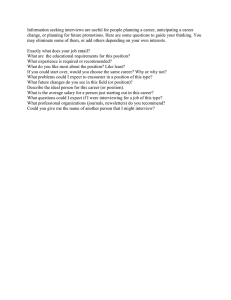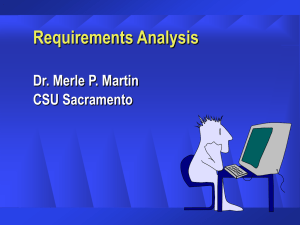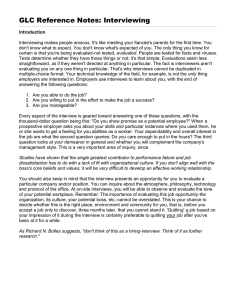When you are studying people’s behaviour or asking them
advertisement
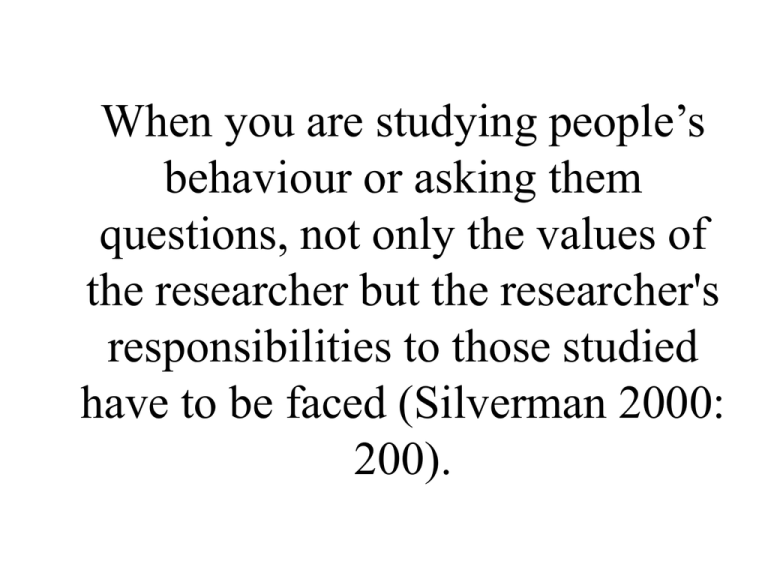
When you are studying people’s behaviour or asking them questions, not only the values of the researcher but the researcher's responsibilities to those studied have to be faced (Silverman 2000: 200). …in terms of the amount of control the researcher applies in the interview situation. Four interview situations • • • • Informal interviewing Unstructured interviewing Semistructured interviewing Structured interviewing First: • Informal interviewing (lack of control over the informant, environment, topic, etc.) • Lack of structure • Method of choice during the first phase of research Second: • Unstructured interviewing: minimum of control over the informant’s responses • Not at all like informal interviewing • Most widely used technique by cultural/social anthropologists • Building initial rapport, access to particular kind of informants Unstructured interviewing is useful for: • Developing formal guides for semistructured interviewing to learn what kind of questions to include. • Building initial rapport: before moving to more formal interviews. • Talking to informants who do not tolerate formal interviews (semistructured and structured ones) Third • Semistructured interviewing: utilise when the ethnographer has only one chance for an interview. • (based on the use of an interview guide • Effective in projects where the ethnographer deals with elite members Fourth: • Structured interviewing: all informants are asked the same questions (uniformity) • Questionnaires Tape recorder • Use in all situations • Different types of transcriptions • Not a substitute for note taking Deference and expectancy effects • 1.when informants tell you what they think you want to know • 2. Tendency from experimenters to obtain results they expect How do social/cultural anthropologists collect qualitative data? • • • • • • • • Video and audiotapes Photographs Newspaper clippings Transcriptions of formal interviews Notes on formal interviews Personal letters Texts written by locals Field notes Four types of field notes • Jottings (“scratch notes”): no detail, general information, key words, etc. • The diary: personal, self-reflexive, refuge, copping with adverse situations, etc. • The log: running account of how you plan to spend and how you spent time and money • The notes: notes on method (M), ethnographic or descriptive notes, and analytical notes. notes on method (M) • Notes about techniques you discover in the field ethnographic or descriptive notes • Notes on environments, observation of process, relationships analytical notes • Notes about making sense of observations, conversations, interviews Two strategies for observing behavior Obvious or reactive and unobtrusive or nonreactive Reactive: • when people know you are observing them • deference problems corrected by long term observation • Produces a lot of data (5 days of observation produced 75,000 words) • continuous monitoring (CM) Nonreactive • Studying people’s behavior without people knowing about it. • Includes all methods: Behavior traced studies, Archival research, Content analysis, Disguised observation Behavior traced studies • Graffiti study by Flores and Sechrest 1969 • Simultaneous analysis of graffiti in public toilets of two cities • Attitudes towards sexuality in two cultures • Dealing with homosexuality: Chicago 42%, Manila 2% Archival research • Truly nonreactive: no change on behaviour (records of births and deaths, migration, etc.) • Possible problems? Content analysis: • Fiction, non-fiction, recorded folktales, newspapers • Reduce the information of the texts to patterns, variables and correlations • Study of personal advertisements: Hirshman 1987 Disguised observation: • (when the researcher pretends to join a group and proceeds to record data about the group.) • The members of the group do not know of his/her observation and recording • What are the possible problems with this type of observation?
